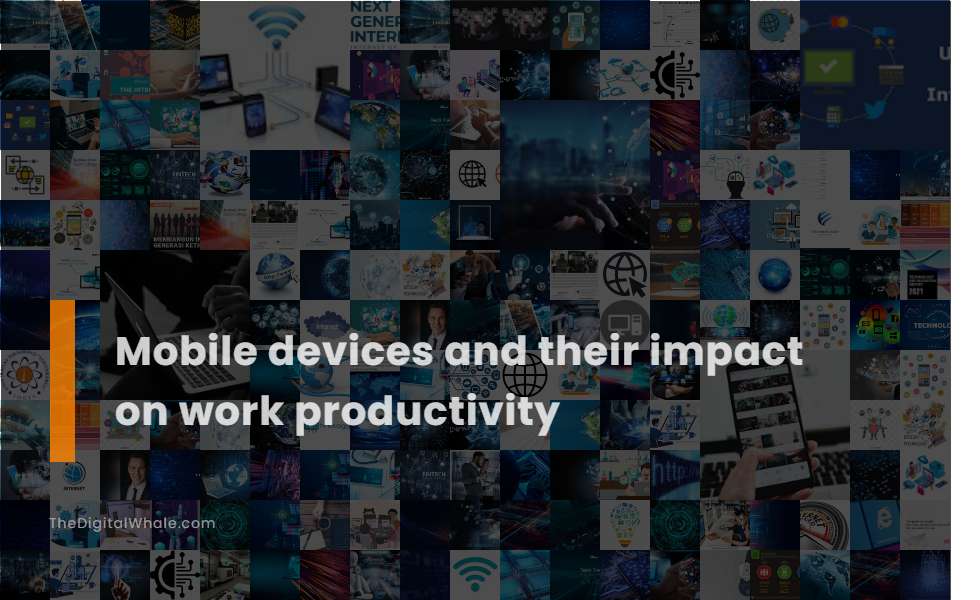Mobile Devices and Their Impact On Work Productivity
What are some advantages of using cell phone technology in the workplace? What are some of the benefits of using mobile technology in the workplace? Let's find out more about Mobile Devices and Their Impact On Work Productivity.

Increased Productivity: 85% of companies have seen a tangible increase in employee productivity due to mobile device adoption.
In recent years, the integration of mobile devices in the workplace has revolutionized how businesses operate, with 85% of companies witnessing a tangible increase in employee productivity. This surge in efficiency has been largely attributed to the flexibility and enhanced collaboration mobile devices offer, allowing for remote work and instant access to essential data and business applications. Companies have embraced this technological shift, leading to a new era where workplace productivity thrives on connectivity and immediacy. For further insights on this transformation, you can explore the comprehensive analysis by visiting the TinyMDM website.
Remote Work Capability: Mobile devices enable employees to work remotely and stay productive outside traditional office hours.
Mobile devices significantly enhance productivity by enabling employees to work remotely, stay productive outside traditional office hours, and facilitate seamless communication and document sharing, thereby increasing overall efficiency and flexibility. According to CareerCircle, remote work allows employees to eliminate distractions, work when it is most convenient, and achieve a better work-life balance, leading to increased productivity and job satisfaction.
Enhanced Collaboration: Mobile devices facilitate seamless communication and document sharing among team members.
In today's fast-paced work environment, mobile devices significantly enhance collaboration by facilitating seamless communication and document sharing among team members, enabling remote work and increasing overall efficiency. Smartphones have revolutionized how employees connect with colleagues, clients, and partners, allowing for efficient communication and collaboration, no matter their location. According to TinyMdm, mobile technology further boosts productivity by providing sophisticated tools like email, instant messaging, video conferencing, and collaboration apps. These advancements empower teams to work effectively from any location, manage tasks in real-time, and ultimately contribute to a more productive workplace.
Time-Saving: Instant access to data and business applications helps complete tasks more swiftly and efficiently.
Mobile devices enable instant access to data and business applications, allowing tasks to be completed more swiftly and efficiently, thereby enhancing overall productivity. This technology provides real-time data access and facilitates quicker response times, enabling employees to make informed decisions swiftly and complete tasks more efficiently. For more insights on how these innovations are revolutionizing efficiency, explore the Impact of Mobile Devices on Productivity in the Workplace. Embracing mobile technology is increasingly pivotal in driving the productivity of modern businesses.
Distractions: Mobile devices can cause significant distractions, such as notifications and recreational apps, impairing focus and productivity.
Mobile devices are a major source of distraction in the workplace, with notifications and recreational apps contributing to a significant loss of productivity. Studies show that after receiving a phone call or text message, there can be an increase in error probability and a notable reduction in focus, leading to a potential two-hour decrease in productive work each day. Furthermore, cell phone distractions, such as alerts and the irresistible need to check social media, can pull employees away from their tasks. This disruption in workflow is reflected in the time it takes to regain focusâaround 23 minutes after each interruption. Such interruptions not only hamper workflow efficiency but significantly lower overall productivity levels. For insights on managing these challenges, the article on balancing productivity provides valuable strategies.
Related:
What are some of the benefits of using cloud computing services? What is the difference between cloud-based and on-premises solutions? Let's find out more about Cloud Computing and Its Applications In the Business World.
Work-Life Balance: Smartphones can minimize work-life conflict when used in line with company policies.
Smartphones can minimize work-life conflict when used in line with company policies, allowing employees to manage work tasks efficiently while maintaining a separation between work and personal life. Effective policies and tools, such as setting boundaries and using features to manage phone usage, are crucial for achieving this balance and preventing distractions that could hinder Productivity.
Error Increase: Receiving phone calls or text messages can increase the probability of errors by 28% and 23% respectively.
Receiving a phone call or text message can significantly increase the probability of a worker making an error, by 28% and 23% respectively, highlighting the substantial impact of mobile distractions on work accuracy and focus. This underscores how digital disruptions can undermine work performance by diverting attention and affecting cognitive functioning. For more insights on this topic, visit the article about Balancing Productivity which explores strategies to mitigate such distractions in the workplace.
Productivity Loss: Up to two hours of work can be lost each day due to phone distractions.
Employees waste, on average, more than two hours per day using their phones for non-work-related activities, significantly impacting productivity and sometimes leading to workplace accidents. More than 1 in 5 employers estimate that employees are only productive for five hours a day, with mobile phones and texting being the biggest obstacles to productivity. This results in up to three hours of work lost daily to distractions. For more insights, you can explore this Business News Daily article, which delves into the extent of mobile device distraction in the workplace.
BYOD Policies: Implementing Bring-Your-Own-Device (BYOD) policies can improve productivity and employee well-being.
Implementing Bring Your Own Device (BYOD) policies can significantly boost employee productivity, with studies highlighting a notable increase as employees work more efficiently on familiar devices, access work files easily, and enjoy greater flexibility and autonomy. Such policies enhance productivity by reducing the learning curve for new devices, allowing employees to work from anywhere, and providing the autonomy to choose devices that suit their preferences. This not only leads to faster task completion but also improves job satisfaction. For a comprehensive understanding of the impact of BYOD on productivity, you can explore detailed insights on how to improve employee productivity with BYOD policies on the Jamf website.
Balanced Usage: Allowing short breaks on mobile devices can positively influence employee well-being and productivity.
Allowing short breaks on mobile devices, known as smartphone microbreaks, can positively influence employee well-being and productivity by providing refreshment and stress relief, making employees happier and more focused at work. This concept is further supported as these breaks throughout the day can increase productivity and improve employee attitudes. Workers who engage in these brief, refreshing pauses on their phones tend to meet deadlines more effectively, contributing significantly to workplace success. For more insights on how mobile devices impact workplace efficiency, the article on Corporate Wellness Magazine explores this phenomenon extensively, emphasizing how modern work environments can adapt to the digital age.
Related:
What is the difference between a data visualization tool and a scientific tool? What is the best data visualization tool for business professionals? Let's find out more about Data Visualization Tools and Their Usefulness In Analyzing Business Information.
